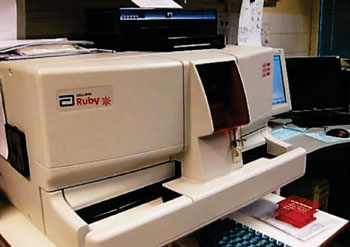Mean Platelet Volume Determines Crimean-Congo Hemorrhagic Fever Prognosis
By LabMedica International staff writers
Posted on 29 Sep 2015
Crimean-Congo hemorrhagic fever virus (CCHF), a Nairovirus within the family Bunyaviridae, causes severe disease and pancytopenia, organ failures and disseminated intravascular coagulation may occur as a result of CCHF infection.Posted on 29 Sep 2015
Changes in the mean platelet volume (MPV), neutrophil-to-lymphocyte ratio (NLR), and platelet-to-lymphocyte ratio (PLR) in patients that have recovered from non-fatal CCHF can be predictors for the duration of hospitalization and prognosis.

Image: The ABBOTT CELL DYN RUBY Hematology Analyzer (Photo courtesy of Abbot Diagnostics).
Scientists at the Recep Tayyip Erdogan University (Rize, Turkey) studied a total of 50 CCHF patients including 27 males and 23 females and a similar age group of 47 healthy individuals including 27 males and 20 females) were included in the study. Hematologic and biochemical tests inclusive of C-reactive protein were conducted on patients and controls. Blood samples were checked for CCHF nucleic acids by real-time reverse transcriptase polymerase chain reaction (RT-PCR).
Biochemical tests were performed using photometric assays using the Abbott Architect c16000 analyzer (Abbott Diagnostics; Abbott Park, IL, USA). Hematological tests for hemoglobin, platelets, white blood cell counts (WBC), and MPV were performed using the Abbott Cell-Dyn Ruby analyzer. The C-reactive protein (CRP) test was performed using the nephelometric method in the Coulter Image 800 autoanalyzer (Beckman Coulter; Fullerton, CA, USA).
The MPV was statistically higher at 8.4 fL (range 6.4 to 9.4 fL) in patients than that of controls at 7.0 fL (range 6.0 to 8.7 fL). The NLR and PLR were similar in both groups. The predictors of the length of hospitalization included decreased white blood (WBC) cell and platelet counts, together with elevated prothrombin time (PT), creatinine and glucose levels. Bicytopenia and pancytopenia could also be seen in patients with CCHF. In severe cases, neutropenia and severe thrombocytopenia are also frequently encountered.
The authors concluded that the MPV was higher in patients, but NLR and PLR were similar in both groups. The MPV, NLR and PLR did not serve as predictors of hospitalization length. However, elevation of PT, creatinine, glucose, along with decreased WBC and platelets counts were found to be predictors of hospitalization period. The study was published in the September 2015 issue of Journal of Microbiology and Infectious Diseases.
Related Links:
Recep Tayyip Erdogan University
Abbott Diagnostics
Beckman Coulter














